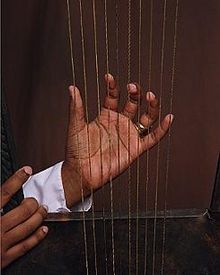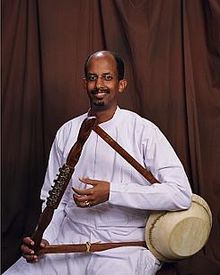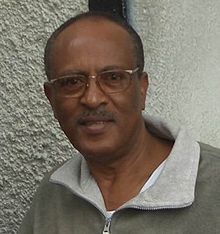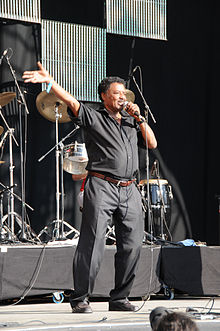- Music of Ethiopia
-
Horn of Africa music  Djibouti
Djibouti
 Eritrea
Eritrea
 Ethiopia
Ethiopia
 Somalia
Somalia The begena's standard finger positioning.
The begena's standard finger positioning.
The music of Ethiopia is extremely diverse, with each of Ethiopia's ethnic groups being associated with unique sounds. Some forms of traditional music are strongly influenced by folk music from elsewhere in the Horn of Africa, especially Somalia. However, Ethiopian religious music also has an ancient Christian element, traced to Yared, who lived during the reign of Gabra Masqal. In northeastern Ethiopia, in Wollo, a Muslim musical form called manzuma developed. Sung in Amharic, manzuma has spread to Harar and Jimma, where it is now sung in the Oromo language. In the Ethiopian Highlands, traditional secular music is played by itinerant musicians called azmaris, who are regarded with both suspicion and respect in Ethiopian society.
Contents
Music theory
The music of the highlands uses a fundamental modal system called qenet, of which there are four main modes: tezeta, bati, ambassel, and anchihoy.[1] Three additional modes are variations on the above: tezeta minor, bati major, and bati minor.[2] Some songs take the name of their qenet, such as tizita, a song of reminiscence.[1] When played on traditional instruments, these modes are generally not tempered (that is, the pitches may deviate slightly from the Western-tempered tuning system), but when played on Western instruments such as pianos and guitars, they are played using the Western-tempered tuning system.
Highland music is generally monophonic or heterophonic.[1] Outside of the highlands, some music is polyphonic; Dorze polyphonic singing (edho) may employ up to five parts, Majangir four parts.[1]
Musical instruments
Chordophones
 A krar player.
A krar player.
In the highlands, traditional string instruments include the masenqo (also known as masinko), a one-string bowed lute; the krar (also known as kirar), a six-string lyre; and the begena, a large ten-string lyre.[3] The dita (a five-string lyre) and musical bows (including an unusual three-string variant) are among the chordophones found in the south.[3]
Aerophones
The washint is a bamboo flute that is common in the highlands.[3] Trumpet-like instruments include the ceremonial malakat used in some regions, and the holdudwa (animal horn; compare shofar) found mainly in the south.[3] Embilta flutes have no finger holes, and produce only two tones, the fundamental and a fourth or fifth interval.[3] These may be metal (generally found in the north) or bamboo (in the south).[3] The Konso and other people in the south play fanta, or pan flutes.
Idiophones
In the Ethiopian Orthodox Church, liturgical music employs the senasel, a sistrum.[3] Additionally, the clergy will use prayer staffs, or maqwamiya, to maintain rhythm.[3] Rural churches historically used a dawal, made from stone slabs or pieces of wood, in order to call the faithful to prayer.[3] The Beta Israel use a small gong called a qachel as liturgical accompaniment, though qachel may also refer to a small bell.[3] The toom, a lamellophone, is used among the Nuer, Anuak, Majangir, Surma, and other Nilotic groups.[3] Metal leg rattles are common throughout the south.[3]
Membranophones
The kebero is a large hand drum used in the Orthodox Christian liturgy.[3] Smaller kebero drums may be used in secular celebrations.[3] The nagarit, played with a curved stick, is usually found in a secular context such as royal functions or the announcement of proclamations, though it has a liturgical function among the Beta Israel.[3] The Gurage and other southern peoples commonly play the atamo, a small hand drum sometimes made of clay.[3]
Popular music
 Tilahun Gessesse, one of the most popular artists in Ethiopia during the local music scene's "Golden Age" in the 1960s.
Tilahun Gessesse, one of the most popular artists in Ethiopia during the local music scene's "Golden Age" in the 1960s.
Ethiopia is a musically traditional country. Of course, popular music is played, recorded and listened to, but most musicians also sing traditional songs, and most audiences choose to listen to both popular and traditional styles. A long-standing popular musical tradition in Ethiopia was that of brass bands, imported from Jerusalem in the form of forty Armenian orphans (Arba Lijoch) during the reign of Haile Selassie. This band, which arrived in Addis Ababa on September 6, 1924, became the first official orchestra of Ethiopia. By the end of World War II, large orchestras accompanied singers; the most prominent orchestras were the Army Band, Police Band, and Imperial Bodyguard Band. Most of these bands were trained by Europeans or Armenians.
From the 1950s to the 1970s, Ethiopian popular musicians included Bizunesh Bekele, Mahmoud Ahmed, Alemayehu Eshete, Hirut Bekele, Ali Birra, Ayalew Mesfin, Kiros Alemayehu, Muluken Melesse and Tilahun Gessesse, while popular folk musicians included Alemu Aga, Kassa Tessema, Ketema Makonnen, Asnaketch Worku, and Mary Armede. Perhaps the most influential musician of the period, however, was Ethio-jazz innovator Mulatu Astatke. Amha Records, Kaifa Records, and Philips-Ethiopia were prominent Ethiopian record labels during this era. Since 1997, Buda Musique's Ethiopiques series has compiled many of these singles and albums on compact disc.
During the 1980s, the Derg controlled Ethiopia, and emigration became almost impossible. Musicians during this period included Ethio Stars, Wallias Band and Roha Band, though the singer Neway Debebe was most popular. He helped to popularize the use of seminna-werq (wax and gold, a poetic form of double entendre) in music (previously only used in qiné, or poetry) that often enabled singers to criticize the government without upsetting the censors.
Contemporary scene
 Alemayehu Eshete, a prominent contemporary Ethio-jazz artist.
Alemayehu Eshete, a prominent contemporary Ethio-jazz artist.
One of the most popular musicians from Ethiopia is the Los Angeles–area expatriate Aster Aweke.
More recently, music from Tigray and Eritrea has become popular in Ethiopia and among exiles, especially in Italy. One of the biggest new trends, however, has been the rise of bolel, a sort of blues-like music, played by sarcastic azmari playing in parts of Addis Ababa, especially Yohannès Sefer and Kazentchis. Bolel musicians include Tigist Assefa, Tedje and Admassou Abate.
Currently the most prominent Ethiopian singer internationally is Gigi. Through her performing with top jazz musicians such as Bill Laswell (who is also her husband) and Herbie Hancock, Gigi has brought Ethiopian music to popular attention, especially in the United States, where she now lives.
Neway was very popular among the youth of the 1980s and early 1990s with such songs as "Yetekemt Abeba," "Metekatun Ateye," "Safsaf," and "Gedam," among others. Abatte Barihun has exemplified all four main qenets on his 2005 album Ras Deshen.[2]
Ethiopiques producer Francis Falceto criticizes contemporary Ethiopian music for eschewing traditional instruments and ensemble playing in favor of one-man bands using synthesizers.[4] Harvard University professor Kay Kaufman Shelemay, on the other hand, maintains that there is genuine creativity in the contemporary music scene.[5] She further points out that Ethiopian music is not alone in shifting to electronically produced music, a point that Falceto acknowledges.[4][5]
Notable Ethiopian musicians
- Abatte Barihun
- Helen Berhe
- Afework Nigussie
- Alemayehu Eshete
- Alemu Aga
- Ali Birra
- Amsale Mitike
- Asnaketch Worku
- Aster Aweke
- Ayalew Mesfin
- Betty Rock
- bizuye the singer
- Bisrat Lemma
- Gigi Shibabaw
- Getatchew Mekurya
- Hamelmal Abate
- Hablul
- Hirut Bekele
- Kassa Tessema
- Ketema Makonnen
- Kiros Alemayehu
- Kuku Sebsebe
- Maki Siraj
- Mahmoud Ahmed
- Mamila & Kichini
- Manalemosh Dibo
- Martha Ashagari
- Mary Armede
- Mulatu Astatke
- Muluken Melesse
- Neway Debebe
- Tadesse Alemu
- Teddy Afro
- Tewodros Tadesse
- Tigist Shibabaw
- Tilahun Gessesse
- Yohannes Berhanu
Scholarship
Ashenafi Kebede studied much in the area of Ethiopian music, history, instrumentation, and composition as a leading ethnomusicologist.
Source
- Falceto, Francis. "Land of Wax and Gold," 2000. In Broughton, Simon and Ellingham, Mark with McConnachie, James and Diane, Orfi (Ed.), World Music, Vol. 1: Africa, Europe and the Middle East, pp 480–487. Rough Guides Ltd, Penguin Books. ISBN 1-02828-636-0
References
- ^ a b c d Shelemay, Kay Kaufman. "Ethiopia", The New Grove Dictionary of Music and Musicians, ed. S. Sadie and J. Tyrrell (London: Macmillan, 2001), viii, p. 356.
- ^ a b Abatte Barihun, liner notes of the album Ras Deshen, 200.
- ^ a b c d e f g h i j k l m n o p Shelemay, pp. 355–356
- ^ a b Eyre, Banning (2005-12-18). "Francis Falceto - Ethiopia: Diaspora and Return (interview)". Afropop Worldwide. World Music Productions. http://www.afropop.org/multi/interview/ID/109/Francis%20Falceto%20on%20the%20Ethiopian%20Diaspora. Retrieved March 10, 2007.
- ^ a b Eyre, Banning (2006-09-15). "Kay Kaufman Shelemay - Ethiopia: Diaspora and Return (interview)". Afropop Worldwide. World Music Productions. http://www.afropop.org/multi/interview/ID/108/Kay+Kaufman+Shelemay-Ethiopia%3A+Diaspora+and+Return. Retrieved March 10, 2007.
External links
- (French) Audio clips: Traditional music of Ethiopia. Musée d'Ethnographie de Genève. Accessed November 25, 2010.
- Addis Music
- Ethiopian Music Channel (EthioTube)
- Ethiopian Music Site (Azmari Bet)
- afrosong.com is a website for Ethiopian Music, mezmur, orthodox song, protestant or christian song, oromo song, tigre song, instrumental
- ADDIS LIVE! Ethiopian Music Internet Radio, Video, Interview with famous Ethiopian artists and short stories
- Ethio-Jazz: Mulatu Astatke
- Buda Musique's Ethiopiques series
- Band of 40 Armenian orphans in Ethiopia (French)
- Ethiog - New and classic Ethiopian musics provided in different players
- Ethiopian Music Video Channel ZedClips Ethiopian Music
- BBC Radio 3 Audio clip (60 minutes): Music of Ethiopia. Accessed on November 25, 2010.
- Ethiopia Music.
Music of Africa Sovereign
states- Algeria
- Angola
- Benin
- Botswana
- Burkina Faso
- Burundi
- Cameroon
- Cape Verde
- Central African Republic
- Chad
- Comoros
- Democratic Republic of the Congo
- Republic of the Congo
- Côte d'Ivoire (Ivory Coast)
- Djibouti
- Egypt
- Equatorial Guinea
- Eritrea
- Ethiopia
- Gabon
- The Gambia
- Ghana
- Guinea
- Guinea-Bissau
- Kenya
- Lesotho
- Liberia
- Libya
- Madagascar
- Malawi
- Mali
- Mauritania
- Mauritius
- Morocco
- Mozambique
- Namibia
- Niger
- Nigeria
- Rwanda
- São Tomé and Príncipe
- Senegal
- Seychelles
- Sierra Leone
- Somalia
- South Africa
- South Sudan
- Sudan
- Swaziland
- Tanzania
- Togo
- Tunisia
- Uganda
- Zambia
- Zimbabwe
States with limited
recognition- Sahrawi Arab Democratic Republic
- Somaliland
Dependencies and
other territories- Canary Islands / Ceuta / Melilla / Plazas de soberanía (Spain)
- Madeira (Portugal)
- Mayotte / Réunion (France)
- Saint Helena / Ascension Island / Tristan da Cunha (United Kingdom)
- Western Sahara
 Ethiopia topics
Ethiopia topicsRegions History Demographic · Economic · Military
Timeline · Early · Kingdom of Dʿmt · Kingdom of Aksum · Zagwe Dynasty · Abyssinian-Adal War · Zemene Mesafint · Second Italo-Abyssinian War · East African Campaign · Derg · Ethiopian Civil War · Ogaden WarEconomy History · Transport · Communications · Agriculture · Energy · Foreign aid · Industrial development · Land reform · Manufacturing · Trade Unions · Companies · Ethiopian Birr · Banks · Taxation · International rankingsPolitics · Military Constitution (history) · President · Prime Minister · Foreign relations · Foreign Aid · Ethiopian National Defense Force · Ethiopian Air Force · Ethiopian Navy · Military history · Human rights · LGBT rightsGeography
DemographicsCulture Art · Cuisine · Education · Ethiopian Christianity · Literature · Media · Music · Public Holidays · SportCategories:- Ethiopian music
Wikimedia Foundation. 2010.
